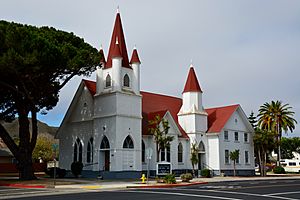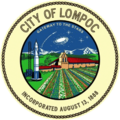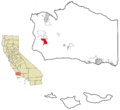Lompoc, California facts for kids
Quick facts for kids
Lompoc
|
|||||
|---|---|---|---|---|---|
|
Veterans Memorial Building
La Purísima Concepción Church
La Purisima Mission
Jalama Beach
|
|||||
|
|||||
| Nickname(s):
"City of Arts and Flowers"
|
|||||
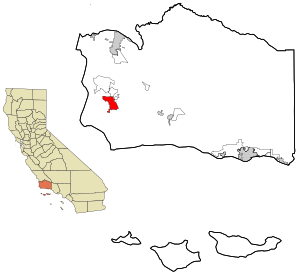
Location in Santa Barbara County and California
|
|||||
| Country | United States | ||||
| State | California | ||||
| County | Santa Barbara | ||||
| Incorporated | August 13, 1888 | ||||
| Named for | Purisimeño:lumpo'o̥: "Lakes/lagoons" | ||||
| Area | |||||
| • Total | 11.70 sq mi (30.31 km2) | ||||
| • Land | 11.62 sq mi (30.10 km2) | ||||
| • Water | 0.08 sq mi (0.20 km2) 0.66% | ||||
| Elevation | 105 ft (32 m) | ||||
| Population
(2020)
|
|||||
| • Total | 44,444 | ||||
| • Density | 3,798.6/sq mi (1,466.31/km2) | ||||
| Demonym(s) | Lompocan | ||||
| Time zone | UTC−8 (PST) | ||||
| • Summer (DST) | UTC−7 (PDT) | ||||
| ZIP Codes |
93436–93438
|
||||
| Area code | 805 | ||||
| FIPS code | 06-42524 | ||||
| GNIS feature ID | 1652745 | ||||
Lompoc (pronounced LOM-poke) is a city in Santa Barbara County, California. It's located on the Central Coast of the United States. In July 2021, about 43,834 people lived there.
The area where Lompoc is now has been home to the Chumash people for thousands of years. They called the area lumpo'o̥, which means 'in the cheeks' in their Purisimeño language. Later, in 1787, the Spanish built a mission nearby called Misión La Purísima.
In 1837, the Mexican government sold the land. After the U.S. took over California, new settlers bought parts of the Lompoc Valley. A company bought land around the mission and started a special community. This community became the city of Lompoc in 1888. Today, Lompoc is often seen as a military town because it is close to Vandenberg Space Force Base.
Contents
Understanding the Name Lompoc
The word Lompoc comes from the Chumash people. The Western Institute for Endangered Language Documentation (WIELD) confirmed that the Chumash Purisimeño word lumpo'o̥ means 'in the cheeks'.
Chumash place names often described body parts. For example, some places were named after the eye, face, or nose. For a while, people thought Lompoc meant 'stagnant waters'. But in 2018, WIELD did more research and corrected this meaning.
A Look at Lompoc's History

Before the Spanish arrived, the Chumash people lived in the Lompoc area. The first Original Mission La Purísima was built in 1787 near where the city is today. People in this area spoke the Purisimeño language.
An earthquake destroyed the mission in 1812. So, it was moved to a new spot about 1 mile (1.6 km) northeast of the current city. After Mexico became independent from Spain, the Spanish missions were closed down in 1833. La Purisima Mission then fell into ruins.
In 1893, a mine for diatomaceous earth opened in Miguelito Canyon. This mine became the largest of its kind in the world. It was once the biggest employer in the valley. The company that owned it even built homes for its workers.

Around 1900, a railroad line opened, which changed how goods were transported. In 1920, a paved road connected Lompoc to Buellton and other parts of California. In 1923, a big naval accident happened off the coast. Nine U.S. destroyers crashed, and 23 people died.
During the Great Depression, the Civilian Conservation Corps (CCC) helped restore La Purisima Mission. During World War II, a training camp called Camp Cooke was located west of Lompoc.
Lompoc grew slowly until 1958. That's when the United States Air Force decided to use the old Camp Cooke as a test site for missiles. It became Vandenberg Space Force Base. The city quickly grew to house the many new workers.

In the 1980s, the Space Shuttle program was supposed to start launches from Vandenberg. Lompoc saw a boom in new restaurants and hotels. People expected many tourists to visit for shuttle launches. However, after the Challenger exploded in 1986, the West Coast shuttle program was stopped. This caused a difficult time for Lompoc's economy.
Lompoc's Geography and Climate

Lompoc covers about 11.7 square miles (30.31 square kilometers). Most of it is land. The city is mainly in the valley of the Santa Ynez River. It sits at an elevation of about 80–100 feet (25–30 meters).
The Santa Ynez River usually doesn't have water flowing on its surface for most of the year. But water flows underground in the sandy riverbed. This underground water refills the city's water supply. Lompoc gets its water from nine wells.
Lompoc's Weather
Lompoc has a cool Mediterranean climate. This type of climate is common along the California coast. The city is usually sunny with a cool ocean breeze. Fog is also common. Snow almost never falls here. The hottest temperature ever recorded was 110 °F (43 °C) in 1987. The coldest was 20 °F (-7 °C) in 1990.
| Climate data for Lompoc, California, 1991–2020 normals, extremes 1917–present | |||||||||||||
|---|---|---|---|---|---|---|---|---|---|---|---|---|---|
| Month | Jan | Feb | Mar | Apr | May | Jun | Jul | Aug | Sep | Oct | Nov | Dec | Year |
| Record high °F (°C) | 88 (31) |
89 (32) |
96 (36) |
105 (41) |
97 (36) |
98 (37) |
99 (37) |
101 (38) |
106 (41) |
110 (43) |
98 (37) |
90 (32) |
110 (43) |
| Mean maximum °F (°C) | 78.6 (25.9) |
80.1 (26.7) |
82.0 (27.8) |
85.1 (29.5) |
83.3 (28.5) |
83.9 (28.8) |
82.9 (28.3) |
85.1 (29.5) |
89.9 (32.2) |
91.6 (33.1) |
85.2 (29.6) |
76.7 (24.8) |
95.1 (35.1) |
| Mean daily maximum °F (°C) | 64.7 (18.2) |
65.1 (18.4) |
67.3 (19.6) |
68.2 (20.1) |
69.2 (20.7) |
70.7 (21.5) |
72.5 (22.5) |
73.3 (22.9) |
74.8 (23.8) |
74.1 (23.4) |
69.6 (20.9) |
63.3 (17.4) |
69.4 (20.8) |
| Daily mean °F (°C) | 54.0 (12.2) |
54.6 (12.6) |
56.6 (13.7) |
57.8 (14.3) |
59.9 (15.5) |
61.8 (16.6) |
64.0 (17.8) |
64.6 (18.1) |
64.8 (18.2) |
62.6 (17.0) |
57.8 (14.3) |
52.7 (11.5) |
59.3 (15.2) |
| Mean daily minimum °F (°C) | 43.2 (6.2) |
44.2 (6.8) |
46.0 (7.8) |
47.4 (8.6) |
50.6 (10.3) |
52.9 (11.6) |
55.5 (13.1) |
56.0 (13.3) |
54.9 (12.7) |
51.1 (10.6) |
46.0 (7.8) |
42.1 (5.6) |
49.2 (9.6) |
| Mean minimum °F (°C) | 32.2 (0.1) |
33.5 (0.8) |
36.9 (2.7) |
38.5 (3.6) |
42.6 (5.9) |
45.6 (7.6) |
49.2 (9.6) |
49.5 (9.7) |
46.6 (8.1) |
41.4 (5.2) |
36.1 (2.3) |
31.1 (−0.5) |
29.9 (−1.2) |
| Record low °F (°C) | 21 (−6) |
26 (−3) |
27 (−3) |
29 (−2) |
34 (1) |
34 (1) |
41 (5) |
37 (3) |
36 (2) |
27 (−3) |
24 (−4) |
20 (−7) |
20 (−7) |
| Average precipitation inches (mm) | 3.29 (84) |
3.66 (93) |
2.80 (71) |
0.90 (23) |
0.34 (8.6) |
0.06 (1.5) |
0.02 (0.51) |
0.01 (0.25) |
0.05 (1.3) |
0.67 (17) |
1.21 (31) |
2.40 (61) |
15.41 (392.16) |
| Average precipitation days (≥ 0.01 in) | 8.1 | 8.6 | 7.4 | 4.1 | 1.7 | 0.6 | 0.6 | 0.3 | 0.7 | 2.7 | 4.7 | 7.7 | 47.2 |
| Source 1: NOAA | |||||||||||||
| Source 2: National Weather Service | |||||||||||||
Lompoc's Population and People
| Historical population | |||
|---|---|---|---|
| Census | Pop. | %± | |
| 1880 | 226 | — | |
| 1890 | 1,015 | 349.1% | |
| 1900 | 972 | −4.2% | |
| 1910 | 1,482 | 52.5% | |
| 1920 | 1,876 | 26.6% | |
| 1930 | 2,845 | 51.7% | |
| 1940 | 3,379 | 18.8% | |
| 1950 | 5,520 | 63.4% | |
| 1960 | 14,415 | 161.1% | |
| 1970 | 25,284 | 75.4% | |
| 1980 | 26,267 | 3.9% | |
| 1990 | 37,649 | 43.3% | |
| 2000 | 41,103 | 9.2% | |
| 2010 | 42,434 | 3.2% | |
| 2020 | 44,444 | 4.7% | |
| U.S. Decennial Census | |||
In 2020, Lompoc had a population of 44,444 people. This means there were about 3,824 people per square mile (1,476 per km2).
Many different groups of people live in Lompoc. In 2020, about 57.3% of the population was Hispanic or Latino. About 29.9% were Non-Hispanic White. Other groups included African American, Asian, Native American, and Pacific Islander residents.
Most people in Lompoc live in households. In 2020, there were 14,104 households. About 38.7% of these households had children under 18 living in them. The average household size was about 3 people.
The population of Lompoc includes people of all ages. In 2020, about 27.4% of the people were under 18 years old. About 13.2% were 65 or older. The average age in Lompoc was 35.7 years old.
There were 14,609 housing units in Lompoc. About 45.7% of these homes were owned by the people living in them. The rest were rented.
Lompoc's Economy
Vandenberg Space Force Base is a very important part of Lompoc's economy. It employs more people in Lompoc than any other business. The base also brings a lot of money to the area.
Other important parts of the economy include:
- The Federal Correctional Institution.
- The diatomaceous earth mine, which is now owned by Imerys.
- The Lompoc Oil Field and its oil processing plants.
- Agriculture, especially growing seed flowers and vegetables.
Lompoc is known as "The City of Arts and Flowers."
Wine production is also growing in the area. The Lompoc Valley is close to the Sta. Rita Hills AVA wine region. This area is famous for its high-quality pinot noir and chardonnay wines. Many small wineries are in Lompoc. You can find places to taste wine in different parts of the city.
After the Cold War, many people who worked in Santa Barbara and Goleta moved to Lompoc. They did this because homes in Lompoc were less expensive. This has made Lompoc a "bedroom community" for these larger cities.
Education in Lompoc
The Lompoc Unified School District serves the city.
There are two main high schools:
- Cabrillo High School
- Lompoc High School
Lompoc also has two middle schools:
- Vandenberg Middle School
- Lompoc Valley Middle School
For higher education, Allan Hancock College has a campus in Lompoc called the Lompoc Valley Center (LVC).
Getting Around Lompoc
State Route 1 is the main road that goes north and south through Lompoc. State Route 246 goes east to Buellton and the Santa Ynez Valley.
You can also travel by train from the Surf train station. Amtrak's Pacific Surfliner train stops there. Amtrak Thruway buses also stop in Lompoc.
Within the city, you can use City of Lompoc Transit buses. There are also buses like the Clean Air Express to Santa Barbara and Goleta. The Breeze Bus goes to Buellton, Solvang, and Santa Maria.
Lompoc's Culture and Arts
The Lompoc Valley Flower Festival is a big event held every year in the last week of June. It includes a parade, a carnival, food, and a craft show. In 2002, a seed company planted a huge "floral flag" with over 400,000 larkspur plants. This was a tribute after the September 11 attacks.
Lompoc has a lively arts scene with many artists, musicians, and bands. Certain Sparks Music is a local music store that often hosts performances by Lompoc musicians.
Local Music Artists
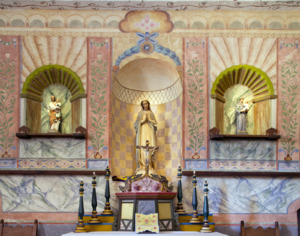
One successful band from Lompoc is Saint Anne's Place. They formed in 2008 and released their first music in 2011. Their music mixes blues and folk rock. They won a "battle of the bands" in 2011.
Emily Wryn is a songwriter from Lompoc. Her music has been played on NPR. She released her first music in 2012. She also performs with Saint Anne's Place and another group called The Lights Electric.
Another band called Millions, led by Randall Sena, played along the Central Coast. Randall Sena also helped produce music for Emily Wryn and Saint Anne's Place in his recording studio.

The Lompoc Theatre
The Lompoc Theatre opened in 1927. It was a popular place for many years. However, in the 1970s, it faced problems because of new movie theaters and television. The last movie was shown there in 1987.
In 2003, a group planned to restore the theater. They worked with the city to raise money to buy it. By 2008, it was estimated to cost almost $10 million to fix up the building. The group couldn't raise enough money at first.
In 2012, a new group called the Lompoc Theatre Project Organization was formed. This group officially bought the theater in 2016. As of January 2020, they are still working to restore the building and raise money.
Lompoc Pops Orchestra
The Lompoc Pops Orchestra started in 1996. It has about 45 musicians. They perform four times a year. Their shows include musicals, Broadway songs, jazz, big band music, gospel, and patriotic songs.
Famous People from Lompoc
Many talented people have come from Lompoc:
- Julián Araujo, a professional soccer player.
- Jeff Bettendorf, a former professional baseball player.
- Mike Bratz, a former professional basketball player.
- Casey Candaele, a former professional baseball player.
- Ryan Church, a former professional baseball player.
- Jeffrey Combs, an actor who grew up in Lompoc.
- Danny Duffy, a professional baseball player.
- Jacqueline Gadsden, a film actress from the 1920s, born in Lompoc.
- Brian Givens, a former professional baseball player.
- Johnnie Gray, a former professional football player.
- Mark Herrier, an actor who graduated from Lompoc High School.
- Winifred Hervey, a TV producer and writer.
- Roy Howell, a former professional baseball player.
- Bill Howerton, a former professional baseball player.
- Napoleon Kaufman, a former professional football player.
- Gabe Lopez, a singer/songwriter.
- Jonathan Majors, an actor, born in Lompoc.
- John D. Nesbitt, a western writer.
- George Perry, an Alzheimer's disease researcher.
- Duane Solomon, an Olympian in the 800m race.
- Roy Thomas, a former professional baseball player.
- Tommy Thompson, a former professional football player.
- Dorien Wilson, an actor.
Sister Cities
Lompoc has five sister cities around the world:
 Cheyenne, Wyoming, USA
Cheyenne, Wyoming, USA Inca, Spain
Inca, Spain Lake Placid, Florida, USA
Lake Placid, Florida, USA Locarno, Switzerland
Locarno, Switzerland Namwon, Republic of Korea (South Korea)
Namwon, Republic of Korea (South Korea)
Images for kids
-
Altar at Mission La Purísima
-
Artwork at Mission La Purísima
See also
 In Spanish: Lompoc para niños
In Spanish: Lompoc para niños















